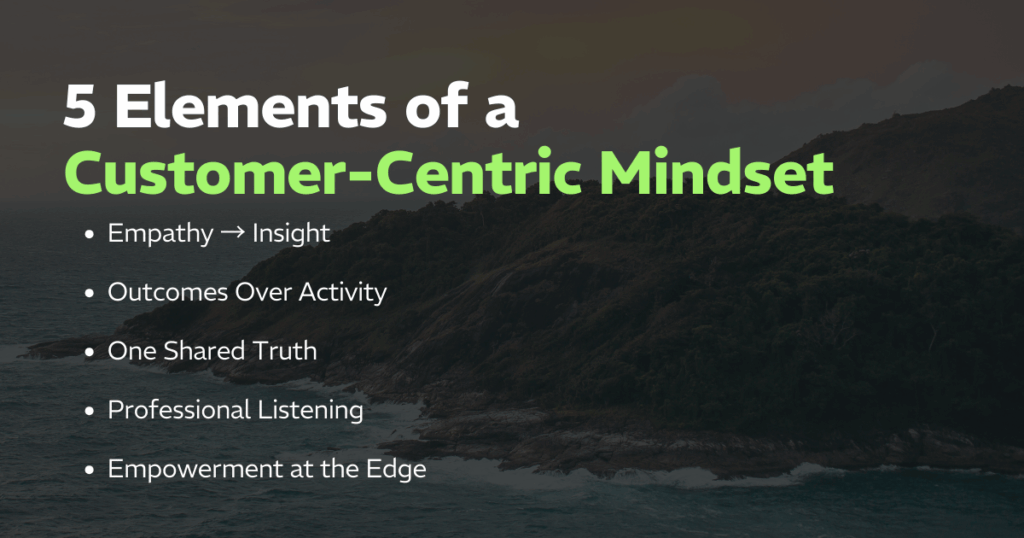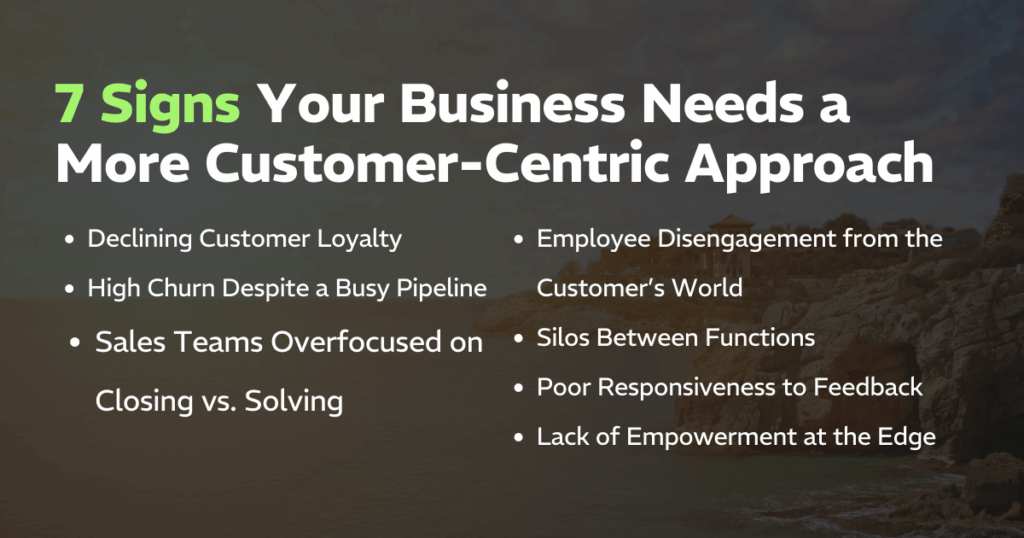Most commercial strategies are built around the company’s goals: Ambitious revenue targets. Faster product launches. Higher quarterly profits. But high-performers understand that sustainable growth starts with a customer-centric mindset, and that means shifting the focus from what the company wants to achieve to what the customer needs to succeed.
Today’s buyers are more informed, more selective, and less tolerant of generic sales tactics. And they are growing increasingly more frustrated and less forgiving of a poor sales experience: 53% will reduce spending after one bad encounter, according to Qualtrics’ 2025 Global Consumer Trends Report.
The message is loud and clear: If you can’t focus on what matters to them, they’ll find someone who will.
Human-centered growth requires a customer-centric strategy for selling. Here’s how to get started.
What Is a Customer-Centric Mindset?
Customer centricity is the discipline of understanding customers’ situations, perceptions, and expectations. The customer-centric mindset makes the buyer the focal point of decisions about products, services, and experiences. In practice, this means:
- Empathy → Insight. Start with the job your customer is trying to get done. Tailor how you help them succeed.
- Outcomes over activity. Measure what matters to customers (time to value, renewal, advocacy, etc.), not just internal counts.
- One shared truth. Align marketing, sales, and service to a single view of the customer journey, making handoffs feel seamless.
- Professional listening. Use client advisory boards, call reviews, win/loss interviews, and customer panels to bring the voice of the customer into weekly decisions.
- Empowerment at the edge. Who is closest to the customer? Give them authority to act quickly.
Every customer interaction is a moment of truth, an opportunity to add value or create friction. And the truth is, customer experience sells.

Why Mindset Matters More Than Frameworks
Frameworks are useful. Metrics matter. But without the right mindset, even the most sophisticated playbooks fall short. Here’s why.
Culture Drives Consistency
When leaders model customer-first thinking, they create a cultural consistency that no framework can replace.
Trust Is Built on Transparency
A customer-centric mindset that prioritizes empathy and openness can build the trust that frameworks alone can’t deliver.
Experience Trumps Process
Loyalty is fragile. One bad moment can undo months of progress and jeopardize customer lifetime value. Frameworks can prescribe steps, but it’s the right mindset that equips employees to adapt in real time and turn challenges into trust-building opportunities.
Growth Compounds Through Retention
The best sellers create value before they capture it. That’s the foundation of customer value creation in sales. Retention compounds when leaders adopt this mindset, as growth is rooted in long-term trust rather than short-term wins.
Great business is always about people, which is why human-centered leadership is the future of growth.
7 Signs Your Business Needs a More Customer-Centric Approach
It’s not always obvious when customer-centric companies start drifting from their principles. Often, leaders notice symptoms — slipping renewals, stalled growth, disengaged employees — before they connect them back to the root cause: a mindset that prioritizes internal goals over putting the customer at the center.
Here are several warning signs that it’s time to improve sales team performance and get more customer-centric.
Declining Customer Loyalty
If repeat purchases or renewal rates are slipping, those are strong indicators that customers aren’t experiencing the value they expect. Loyalty is earned by consistently delivering on your promises.
High Churn Despite a Busy Pipeline
A pipeline full of activity doesn’t mean much if deals aren’t closed or customer retention is poor. High churn suggests misalignment between what was sold and what was delivered.
Sales Teams Overfocused on Closing vs. Solving
When salespeople chase transactions instead of solving problems, win rates flatten and long-term trust erodes. Customers will notice the difference.
Employee Disengagement from the Customer’s World
If employees aren’t curious about customer challenges or don’t understand how their work impacts outcomes, they’ll struggle to deliver meaningful experiences.
Silos Between Functions
Silos prevent marketing, sales, product, and service teams from operating seamlessly. Customer handoffs suffer, disrupting the customer journey. Make sure your team aligns on one shared view.
Poor Responsiveness to Feedback
Customer satisfaction isn’t just about the initial experience. If you collect customer feedback but fail to act on it, are slow to react, or are inconsistent in your responses, the customer experience will worsen. Moreover, customers will lose confidence that their voice matters.
Lack of Empowerment at the Edge
When frontline employees can’t resolve issues quickly without escalation, small problems snowball into frustrating experiences.
If two or more of the above situations sound familiar, you aren’t alone — and you can capture significant upside by shifting toward a customer-centric mindset.

How to Build a Customer-Centric Mindset Into Your Culture
The best leaders understand that culture is the ultimate competitive advantage. When you hardwire customer focus to your operating model, performance follows. Becoming a customer-centric business requires discipline, daily behaviors, and visible leadership commitment.
Here’s how leaders make that operating model real.
Train for the ‘Soft Skills’
A culture of curiosity is coached internally before it shows up in the field. Equip employees with discovery skills, jobs-to-be-done frameworks, objection handling, and professional listening. Practice call reviews together, role-play real customer challenges, and teach teams to capture context and insight. Product training isn’t enough.
Lead From the Top
Leaders set the tone. Executives who sit in on customer calls, read feedback weekly, and protect time for problem-solving send signals about what matters most. When leadership demonstrates presence and empathy, those traits cascade throughout the organization. This kind of visible commitment directly improves sales team performance.
Communicate Clearly
Define who you serve, the promises you keep, and the value you create — then do it all over again. Translate the strategy into simple language that people can remember and act on. Clear, consistent communication creates alignment, helping employees connect their role to the larger customer experience.
Align Teams with the Customer Journey
Map the entire journey together, identifying moments of truth where the relationship is won or lost. Assign clear ownership of these moments, and create feedback loops so no team operates in isolation. When marketing, sales, service, and product share the same journey view, handoffs become seamless and accountable.
Make Listening a Daily Discipline
Customer listening isn’t an annual survey — it’s a daily habit. Stand up weekly “voice of the customer” cadences: client advisory boards, win/loss interviews, community forums. Summarize insights, assign owners, and track actions. Reference customer input to shape priorities.
Done consistently, you’ll reinforce a growth mindset and ground the strategy in reality.
Empower Employees to Act
Push decision rights to the front line. Customers don’t want to wait for escalation. Establish clear guardrails, spotlight decisive recoveries, and reward initiative. When autonomy is operationalized, speed and empathy become the default experience.
Reward What Matters
Incentives shape behavior. Shift recognition away from internal activity metrics and toward customer outcomes: time to value, renewal, expansion, and advocacy. Spotlight your people who helped customers succeed, not just those who closed deals the fastest.
Customer-Centric Approach Examples to Inspire You
Mindset turns into momentum when you see it in action. Across industries, some of the world’s most admired B2C and B2B brands have put embedded customer centricity in their culture and strategy.
Amazon: Customer Obsession as an Operating System
Amazon leaders start with the customer and work backward. That clarity scales because it’s wired into hiring, reviews, and daily rituals. The company’s obsession with eliminating friction shows how a simple principle can transform an enterprise.
Ritz-Carlton: Putting Empowerment at the Edge
Customer service at Ritz-Carlton starts with frontline employees, who are trusted to resolve problems and delight guests. This empowerment means guests experience care in the moment, not in the escalation queue.
Intuit: Embracing Design for Delight (D4D)
Intuit’s Design for Delight approach pairs deep customer empathy with rapid experimentation and observing customers in context. Weekly sprints help employees synthesize insights, test small, and learn fast. Their “Follow-Me-Home” practice embodies professional listening in action.
Disney: Creating Magic Through Experience
Disney treats every customer as a guest, empowering every employee to deliver happiness. The company’s relentless focus on creating memorable experiences turns ordinary interactions into lifelong loyalty.
Salesforce: Connecting the Customer Journey
Salesforce demonstrates how to unify data, experiences, and people in the B2B world. From Dreamforce to personalized campaigns, Salesforce builds connected journeys where seamless handoffs are the expectation, not the exception.
Patagonia: Choosing Values That Deepen Loyalty
Patagonia aligns customer experience with its environmental mission. Through initiatives like Worn Wear, the company encourages customers to repair, reuse, and trade in gear. This authentic alignment between values and customer needs builds uncommon loyalty.
HubSpot: Acting on Feedback Fast
HubSpot operationalizes customer centricity by hiring for customer obsession and acting on feedback within 48 hours. HubSpot’s systems for measuring NPS and closing the loop on insights show that speed matters in building trust.
These customer-centric organizations demonstrate that the customer focus spans industries and business models. Whether B2B or B2C, successful organizations empower employees, invest in technology to understand customers better, act quickly on feedback, and align their entire organization with customer success, not just product features.
Is Your Team Truly Customer-Centric?
The true test of customer centricity isn’t found in a slide deck or dashboard. It shows up in how your people think, what they prioritize, and what decisions they make. To gauge how deeply this mindset is embedded, leaders can ask these diagnostic questions.
Can Every Employee Name Our Top 3 Customer Outcomes?
If employees can’t articulate the outcomes customers care about most, they’re likely measuring the wrong things. Outcomes such as time to value, renewal, and advocacy can anchor daily work in what matters.
Are Incentives Tied to Renewal, Expansion, and Advocacy?
When compensation is tied to volume or short-term revenue, less-than-optimal behaviors will follow. Linking rewards to customer outcomes, by contrast, encourages people to invest in relationships that last.
How Fast Can Frontline Employees Resolve Issues Without Escalation?
Speed and empowerment are essential to the customer’s experience. If frontline teams can’t act decisively, their frustration will grow, and their loyalty will erode.
Do Leaders Model Customer-Centric Behavior?
Employees take their cues from the top. When executives sit in on calls, engage directly with feedback, and champion customer issues, they prove that mindset is as important as metrics.
Get to Work Building a Customer-Centric Mindset
If you want easier access, faster deals, and durable growth, build the mindset that earns customer wins and loyalty. Teach your team how to create value in every interaction, then reinforce those learnings with leadership behaviors, training, and incentives.
The shift starts with leadership. When you model customer-first behavior, your team will follow — and performance gains will compound over time.
Are you ready to inspire your people with a customer-centric mindset that drives results? Book Ryan’s Sell for Impact keynote for your next sales meeting.








![[RYAN] Featured Image - Effective Pre-Call Planning for Sales Success [RYAN] Featured Image - Effective Pre-Call Planning for Sales Success](https://ryanestis.com/wp-content/uploads/bb-plugin/cache/RYAN-Featured-Image-Effective-Pre-Call-Planning-for-Sales-Success-1024x683-panorama-5450085f2a20c8468e6be608dffdca5c-.jpg)
![[RYAN] Featured Image - Effective Sales Training Image of Mountain in the background](https://ryanestis.com/wp-content/uploads/bb-plugin/cache/RYAN-Featured-Image-Effective-Sales-Training-1024x538-panorama-675783a5b1248eec528a45c7f36d5e73-.png)
